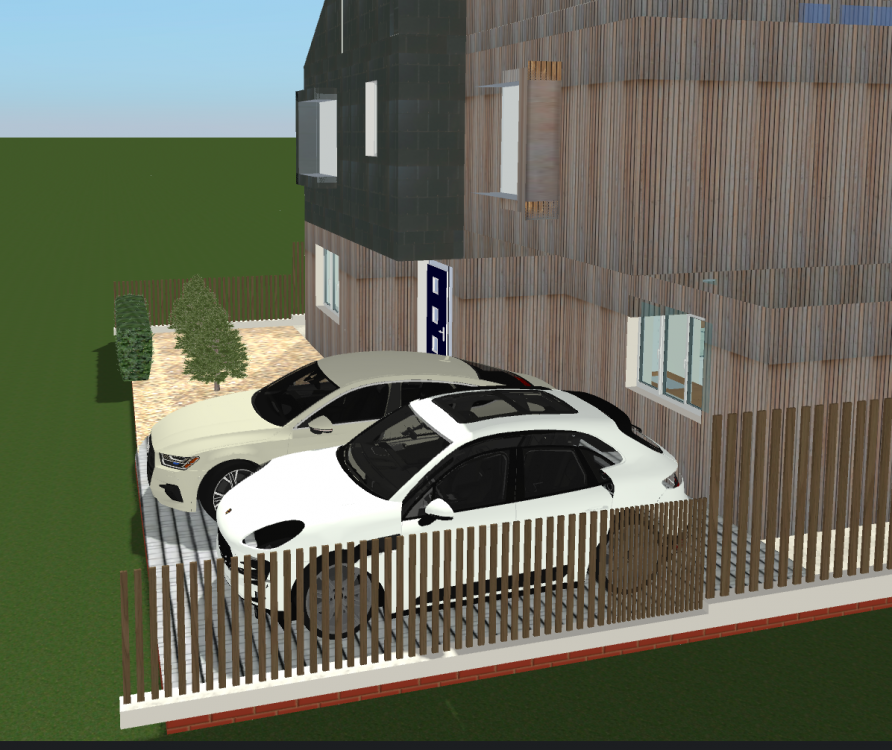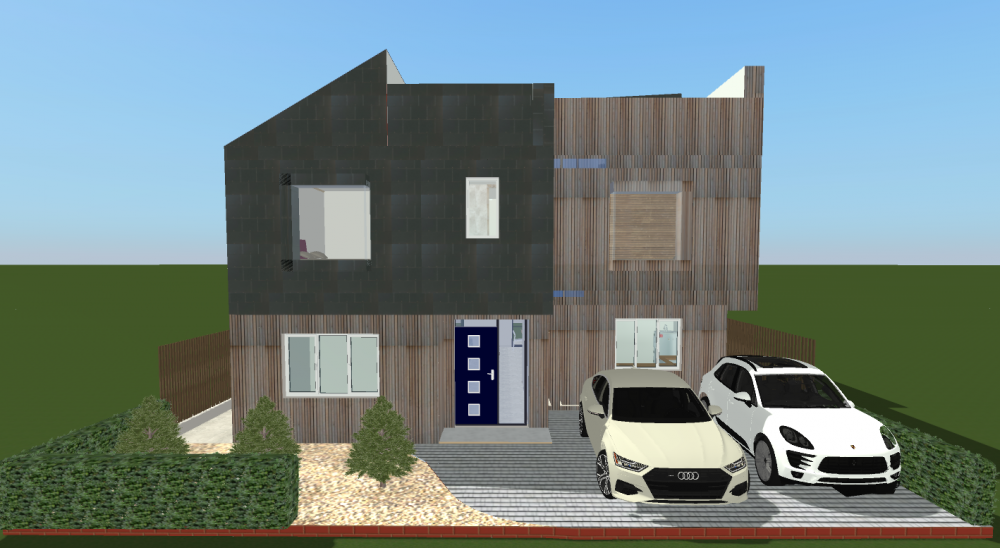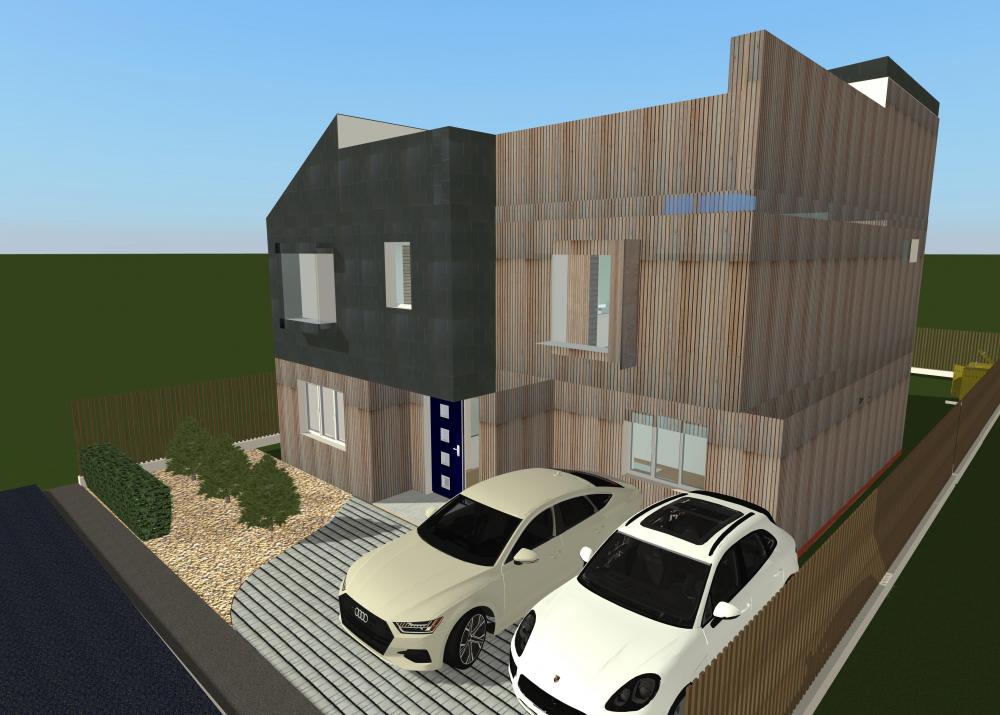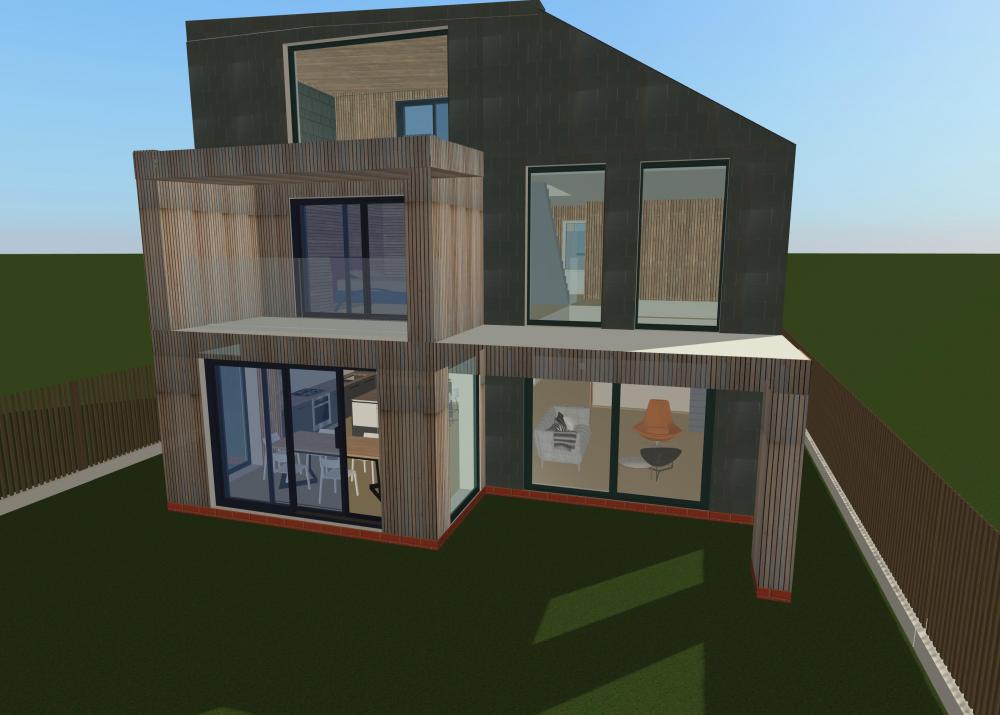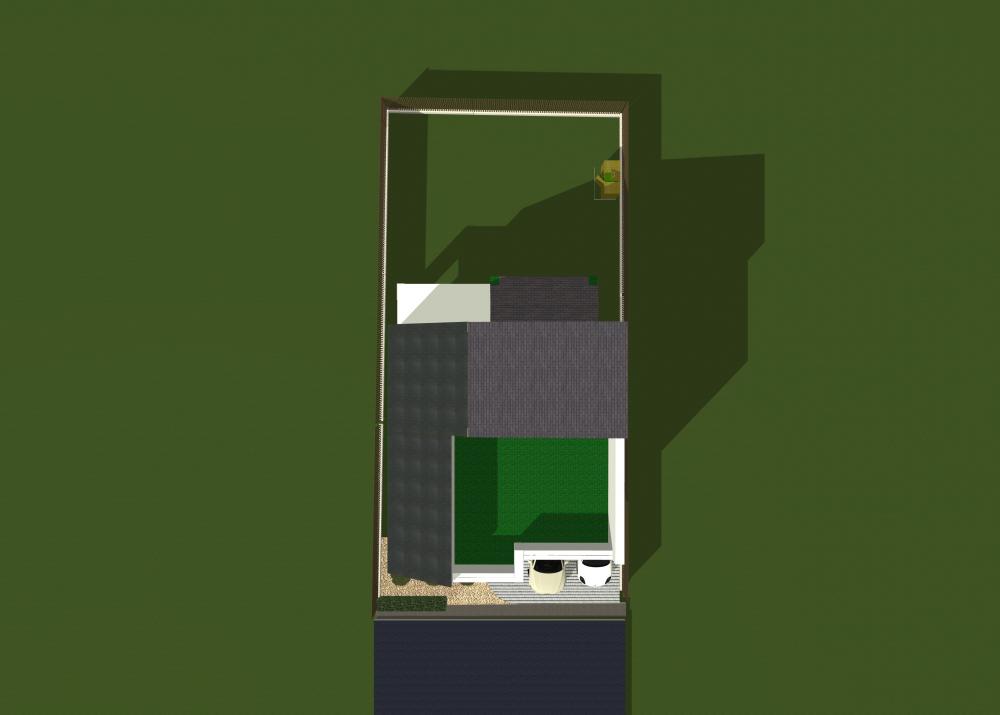Leaderboard
Popular Content
Showing content with the highest reputation on 01/11/21 in all areas
-
So finally got round to finishing all the decorating over the Christmas break! The front window will be getting swapped for triple glazing at some point, but other than that and a tiny bit of skirting board its complete.4 points
-
@zoothorn We keep going round in circles your new room is nit getting hot. Turn the radiator off and just try heating it with a fan heater of know power. If the fan heater gets it toasty warm then the problem is with the heating system. If a fan heater can't even get it warm, then the problem is with the room.3 points
-
@PeterW Just wanted to report and say thank you. Little over 3 days in and condensation is almost gone after installing overflow pipe cut-offs. Top job.2 points
-
If you have a local bathroom manifold then you need 15 or 22mm to the bathroom, which increases the delay for hot water, unless you rely on secondary circulation. The goal of central manifold and 10mm radial feeds to basins is to: - Avoid need for secondary circulation but still get short delay for hot water. - Reduce heat losses (due to less water in pipes). - Central isolation point is also useful.. and for some people this is preffered over finding suitable locations for manifolds in bathrooms. In our case our basins are at 4, 5, 6, 12, 13 and 14m. With 10mm it'll take between 2.5 and 8 seconds at 6 l/min to empty these runs yet with 15mm that goes up to 6->20 seconds. (With 22m it's 13->42 seconds). Given the maximum 8 seconds is a guest en-suite, we'll likely not bother with any secondary circulation at all. Planning to use Uponor 12mm (8.8mm ID) as the Hep2o 10mm only has 6.7mm ID which would mean 2.8m/s velocity at 6 l/m (vs. 1.6m/s)1 point
-
I was thinking it could be a completely stand alone system (temporarily). So connect the end of the UFH loop up to each other with a pump and willis heater. You’d also needs an ev and fill loop. please see my CAD drawing below ? (drawn with my finger on a phone after a bottle of wine - not my best work ?). Hopefully an actual plumber /heating engineer could tell you if this was ok.1 point
-
Hi DevilDamo, apparently when the BCO came to visit he identified the existing doors were fire doors so the replacement door would have to be no worse than before. Anyways I've been told I need the fire door with 3 hinges and the wireless mains powered alarms in the kitchen and lounge then they'll issue the completion certificates. Have agreed to all that...well I don't really have a choice..? Its not the end of the world and hopefully it won't take too long to get everything done, hopefully get it all sorted by the end of the week.1 point
-
For future reference never cut a tree that close to the ground, cut it off at 6 feet high so you would’ve had some leverage.1 point
-
Don’t even think about it diy block laying isn’t going to happen, if you have no experience in this but you want to have a go then you need to go ICF blocks your block work will be weaving about like a donkeys hind leg. Ive had years of bricklaying experience and I knew that my house on my own would be too much, so I built in icf, it’s the same type of skills, must be level plumb straight. But the good bit is you get time to adjust things until you are happy, then pour the concrete, with brickwork you don’t get much time for adjusting before it’s pissed and gone off, then the only thing is to knock it down and try again. If you have little experience then you need a timberframe kit erected or icf and get a team to help you finish.1 point
-
Hi I’m Chris a newby on here but not to self building , we built our house 10 years ago in Washington ( in the last street in Sunderland much to the amusement of my Newcastle Utd loving mates) Tyne and Wear. More recently we have been buying and selling and we’re currently on with our biggest development knocking 2 properties into one and a big extension they’ve been derelict for 12 years so it’s quite a task, been doing it part time for 2 years and starting to see the end of it though still lots to do . I’m not a tradesman a good DIY all rounder with 2 golden rules I never do electrics or gas , plumbing makes me nervous but I’m getting better at it, test well before you plaster !! starting a thread soon in UFH regards1 point
-
I thought was being positive!!! Building a house is hard hard work. Actually lifting each block, each 150mm deep window cill measuring over 1m( you will very quickly regret wanting large windows) lifting each and every concrete lintel, shoveling tonnes and tonnes of sand and cement into a mixer then wheeling it in then shoveling it out onto a mortar board then using a 13 inch trowel cause it was £5 cheaper than a 10 inch will have you aching in bits you didn't even know existed. But sure its worth the addiction to pain killers and vodka. And as Ian has pointed out if it ain't right at the bottom then you have no chance.1 point
-
Klotzen nicht Kleckern That is, concentrate and do not disperse your efforts. In self-building, it is often best to decide on a couple of things and do those - rather than pfaff around over bits of everything. You won't learn 10 trades in a year, so do no try. You can decide to get a couple of skills deeply, or perhaps provide dogsbody type skills to enable you to exploit your pros effectively That might be tidying up the site and labouing for a brickie, or making sure that materials are all in the right place so your £30 an hour whatever does not waste their time. Or becoming an Ebay-sniffer to get high quality things at a low quality price. Or indeed realise that you may add more value by working because you are paid more than you save by doing brickwork slowly. Or spend your time building a knowledge of what you want so you can avoid building it 10% bigger than you need. There will be a collection of things that nobody except you can do - find out what they are. One is to be the keeper of the copy of Spons. (I see that Buttercup has not mentioned the wall that blew down ? ? .) F1 point
-
Cheerful bloke that @Declan52 in'he ? Trouble is , he's bang on right. 5 years in, and I'm just about used to it. This is the most important thing he said.... Our walls ( well two of them - because by then I'd sacked the builder) bear more resemblance to a propellor than a wall. Those faulty walls caused the following headaches Increased costs in respect of; first floor joists (up to 15mm variance in some cases cladding ( hours of setting up the battens correctly) plastering ( found a magician plasterer who corrected most of the errors If the builder had spent even one day more getting the lines and levels accurate, I would have saved a good deal of money. I rationalise it by saying that I have learned a great deal from the errors - and indeed I have. But Twinkle Toes indoors could have had a better kitchen , I could have had a couple of weeks holiday etc, etc. I think they call it a steep learning curve.1 point
-
1 point
-
I know but I’ve only got a framing square lying around and one pair of hands at the moment so it’s tricky. 5355 vs 5310 was the best I got it but I’m going to move it once I can get rid of the holly stump.1 point
-
1 point
-
We had a log burner in our previous home and it was lovely but I had insulated the old cottage that much when we lit the fire (5KW) it used to send me to sleep! Every day is a learning day! I had the number of the tech guy who stat I was using and after a call just now he is sending me an updated sender unit that is more suited to my house with a greater degree of hysteresis and a degree of self learning so what a great service that is.1 point
-
Yes, so an incentive to only take what you need. When I was with them (2015/6) they just need an email to release funds - no valuations once the solicitor did the initial paperwork.1 point
-
18mm plywood either side of the existing timber and structural screws and ‘sister’ them together. or coach bolts1 point
-
funny enough I just got the Loxone system programmed yesterday. 4 rooms have lights installed, but still no lightswitches due to delays with the humidity holding up the flooring which is holding up skirting boards holding up wall decoration, so I can control lighting from anywhere in the world on my phone more easily than anyone else can from within the room itself. only installed 2 LED strips so far, but they're looking great. it's a bit ironic that the first ones to be installed are necessarily the ones that are hardest to get at / maintain later on, which really raises the stakes on getting these first ones right first time, while still learning how to do them nicely We didn't bother with very fancy bathroom lighting, but for the tub my top tip is to get a couple of these small sound actuators and glue onto a suitable panel on it: https://www.amazon.co.uk/dp/B071LH266V They don't look much but attached to the correct surface they sound surprisingly good. That's the only speakers I've installed so far, so they've turned into my "builder's radio".1 point
-
1 point
-
unfortunately it was not designed properly, if mine did not work properly then I only have myself to blame as I designed it (with much help on this forum) but I had no prior knowledge how they worked, only limited plumbing knowledge. This set up was designed by a company who I think are completely at fault. Valiant have been good at solving the noise problem (eventually ). But the buck stops with the designer/installer but zoot is getting no answers from them and suffered stress from the problems. If it were me I would go to trading standards, then the gov dept that paid fir it under a grant scheme as others may be getting the same shit service. At the risk of repeating myself it is not fit fir purpose (the basis for buyers rights under law.) (here endeth the sermon ?).1 point
-
I had this just the other day, I have a very well insulated room within an uninsulated building , the room had not been used for some time and I had not been in there during the long freeze, the other day I went in there and exterior temperature was up but the room was absolutely bloody freezing as the temp had slowly dropped over the cold period and as it was very well insulated it retained the cold long after the weather had warmed up..... I had to open the windows and doors to bring it to the same temperature as outside !1 point
-
On site surveys the numbers with 3 decimals are the height (normally) above ordnance datum (AOD) - which is a recognised benchmark height based on mean sea level.1 point
-
Yeah I completely agree, hence me trying to ignore the current CH issue for a second. As I feel there are 2 parts to tackle: 1) the on-going saga of why the ASHP isn’t doing what we expect. 2) How to stop any heat loss when some is produced - even background heat would keep a house above 10*c in my experience.1 point
-
The Mcalpine traps work well with utility room floor similar principle to hep valve. https://www.plumbers-mate-sales.co.uk/mcalpine-gully-tile-silicone-non-return-valve---39000054-4504-p.asp1 point
-
That looks amazing , would still rather have a bar on the top foor though ?1 point
-
Black UPVC Quadrant or small profile ..? Can’t see the exact dimensions but should be able to get something1 point
-
1 point
-
Not sure if it's been said but I would push back the stairs. They look incredibley close to the front door, as in you have to open the doors fully to get around the bottom tread. You have a large spacious entrance hall that your immediately making feel cramp in a pinch point.1 point
-
1 point
-
Shouldn’t that say @pocster will be along with his plans for his HA Laser show .. as he’s still tiling his floor .. and he will be doing it some time in May...1 point
-
No there is nothing tricky about a combined foul and surface water sewer. I'd say keep them separate and combine just before connecting to the public combined system. You are right that the falls for foul water pipes will be fine with surface water, but may not be for capacity unless maybe you go for larger than 110mm pipes.1 point
-
Are you fitting the stone worktops yourself then? I thought most came supply and fit. If supply and fit, try and convince the supplier that this is a new build house and the fitting of the worktops is the last item needed for completion and then they will zero rate supply and fit.1 point
-
I think upvc or anything painted might scuff-up over time. What about timber with a bit of aluminium angle trim screwed over it?1 point
-
The basic design seems very sound. During lockdown my wife and I have discussed if we should have had a basement for a large gym. The main issue seems to be a severe lack of storage. Only one bedroom has a wardrobe and there are no cupboards anywhere (maybe under the back of the stair is a cupboard and not shown?). Depending on whether you will mainly use the front or back door I would want a large cupboard there for coats shoes etc. I am guessing it might be the back door in which case I would steal some space from the utility room. My in laws have a house with no doors on the main floor. When there are a few kids in the house it is horribly loud, I would consider being able to separate more of the ground floor. I too am not a fan of the WC at the back, although it is not so bad off a hall and not the utility room as I sometimes see. If I was making bigger changes I would consider can the utility room go where the rear hall and WC are. Then the snug where the utility room and part of the current snug are and then have an area of storage and WC next to the front door. This would require a beam in the wall and may not work out, but is worth considering for a more conventional layout. A minor point is I would not have the fridge on the other side of the island from the hob and sink. That is going to be very annoying. It looks like I would put it next to where the sink is as this is the only area of wall where it would fit. The door to the utility room could move down a little.1 point
-
I like the mix of materials - tying in with trad elements, whilst still showing off the more recent elements esp. at the back. It has a feel of fitting in, which I think is pleasant. I think the presentation gently hints at the scale, which is good. It looks comfortable in the immediate landscape. I can feel faint echoes of previous movements in the extra glass in a fairly trad frame, and the horizontal emphasis. And it is a substantial house (I make it 350 sqm or so). Larger houses are a balance between the same number of larger rooms, and a larger number of normal size rooms. I tend towards larger rooms on that spectrum. But I am not convinced that every sqm is singing for its supper here. I wonder if you could actually do everything it is currently doing, and make it 15% smaller, or perhaps build in a lot more options. I grew up in a large (5000 sqft), 4 bedroom house (a so-called "Derbyshire Hall" ie small ex-manor house) where the smallest bedroom was 15ft x 15ft, and my room had another spare bed and a full size table tennis table in it. It was wonderful, and we were able to repurpose everything several times - at one time three of us worked from home; another my mum ran a B&B for a few years; and we could create a 1200 sqft party space and still have another big lounge and a smaller lounge left over, as there were about 4 18ft reception rooms. I want to encourage you to explore your thinking on two things - flexibility and suitability for the different ways and arrangements for living you may want in the future, and the internal / external interface. If you have done this already - great. (Remember with my critique here that you can probably mess about with internal arrangements after planning - they are overwhelmingly concerned with appearance and effect on others, and internal arrangements are mainly none of their business - that is more for Building Control.) A few specifics. If you wanted to, I think you have plenty of space for all-ensuites plus a family bathroom. Or five + five if you wanted ?. Is there going to be a cloak room for visitors to put coats, boots and brollies, and perhaps for mobility scooters etc in the future? The hallway / landing will look very imposing, but do you want 10% of your house dedicated to looking imposing? What else can it do? Ramp access to the back garden (wheelchairs but also wheelbarrows and bikes) needs to be there and integrated. is there provision for a lift for the future, or perhaps to include now? I would add one now and use it to move heavy stuff between floors. Bearing in mind COVID, how will two people work from home? In a big house that should imo be possible without stealing lounges or kitchen tables. Is garage / workshop / secure garden storage covered in your plans? Hoping here that you have a sort of 'garage block' somewhere on your plans. A different lens. Can I encourage you to think through a few 'Use cases", to see what it highlights? These also apply to people you may sell it to in future, as flexibilty. "Two people working from home" is one. Also... Living here when older and getting frail. Parent coming to live with you needing something self-contained. Boomerang kids who want to be semi-detached yet present. One of you has an accident and ends up in a wheelchair. Overlap with older parent case. Child takes up the trombone. ** Space for biggish social events. (one way - our entrance hall was about 16x20 plus a galleried staircase so we had parties for about 20 around a big antique table there). Running a business from home, and receiving visitors. (needs semi-public space for office and eg loo, without invading the private family space. Reflecting the idea of public / private space hierarchy) Life with a dog or three. Briefly on the internal / external thing You have only given us immediate landscaping, so perhaps think about another set of cases - where will you sit outside / sunbathe outside / play boules / roll the dog / have a BBQ / entertain in summer. My top recommendation would be to see how other people handle garden design, and integration with the house. Tricky at the moment, but small early 20C country houses often do it very well / accessibility, as do modern architects who pay attention to that aspect. Lutyens was especially good. Orgs such as the Landmark Trust have modern houses where you can stay, and even the National Trust does modern now. I'll stop there, and wish you all the best. Stay curious, and don't stop thinking ? . Ferdinand * I have the orientation issue at my house - S faces the road. I plan to make the front more private and turn it into a sunny courtyard garden.1 point
-
I like the house design. I would prefer a WC / cloakroom off the hall, so you can have you coat, shoes, go to the loo etc away from having to walk through the kitchen, but you may normally come in via the back anyway. Also the open plan family living room would not be to my taste, but I am not going to be living there! If you build it exactly as is I think you will have a great home.1 point
-
Have you thought about the orientation? It looks like you have a large north facing balcony / terrace, but I have had a few lockdown drinkies so may have misread this.1 point
-
That is some house.. no wonder you are excited. I wonder what the views are you'll have. Setting aside the Architectural scheme. At first glance there are a good few opportunities here to explore in terms of structural design particularly on the rear elevation in terms of sideways horizontal) stability of the building. The corner windows on the rear elevation? Frameless glass (cantilevers?), corner posts or hanging from the roof structure..? You have that large area of glazing on the rear elevation coupled with a partial basement.. in Engineering terms it sparks interest. what is the ground like.. will there be significant differential settlement.. if so how much and if realised how do you deal with that while not compromising on the Architectural design intent.. The form of construction; steel frame, timber frame, traditional masonry or some hybrid with ICF basement.. so many opportunities / options! All the best. Look forward to seeing how this develops.1 point
-
1 point
-
1 point
-
Lots of good points here. Miri Piri.. good points. You'll get there faster than you think.. break the task down into pieces, if your not sure about something then leave it and look at something else.. look at the finishes.. exciting stuff.. sleep on it. It's confusing at first but you are putting the work into it and suddenly it will all come together for you. Every day is a school day and I think we are all born stupid. In terms of designers..competancy, vision etc is a key and a prerequisite.. but it is your project. It's essential that you actually like the person, not all with agree with me but.. This is your home (not a commercial project) and if you don't take to them in the first few minutes then carry on looking, no matter how good the cv looks, trust your gut feeling and this will serve you well. No matter what you read about contracts etc, this is also a people business too.. your journey should be fun and rewarding and strangely builders are human too and like working for good folk who will give and take. If things start to get a bit rough then you need folk that like each other and this make it easier to sort things out. On big project's, HS2 say every one knows that there are no friends in the desert at the first meeting. You'll read lots of stuff about being hard nosed but it's not always the case..just be firm and fair, make sure you pay on time for a fair days work and there are a lot of builders who will return the favour!1 point
-
Welcome. IMO the key things are 1 - to have a short eg one page statement of what you want to achieve, and what you want to do yourself. There is a thread of a few of these somewhere. 2 - to keep referring back to it. 3 - to choose your consultants etc slowly and carefully. You will need time to learn; take it and use it to become a knowledgeable client. If you are starting from scratch say a year of reading around and mulling over. 4 - see their past work. They all have their own style / language, and you need it to match yours approximately. If it does, you don't have to pay them to learn a style that does. 5 - To control costs, define the scope carefully rather than browbeating about spending less. Consider where each can add value. eg architects for ideas and inspiration, architectural technicians if you really want a competent drawer of plans. There is value in engaging an architect up to the stage of getting PP, and then taking a reassessment. I had some reflections here, which may be useful. It was for a big project involving getting PP and selling with Outline PP to a developer. Ferdinand1 point
-
For any new build dwelling, I would always insist the client having a topographical survey carried out. It has already been mentioned before, but the survey would help with the drainage and landscaping design. It’s also an important factor in being able to set out the new house with co-ordinates as opposed to distances from adjacent buildings or structures. The survey fee in the overall grand scheme of things isn’t a lot of money to spend, especially the time and money it would save you in the future should something go wrong.1 point
-
Those are very brief briefs. I could not let go so much so we gave more guidance in respect of the outcomes we wanted from our build (plot already purchased at this point so we knew how to orient certain features e.g. lounge / kitchen to patio). As above, we were not prescriptive about the look and most of the layout. Here it is, I have deleted personal details. We also provided a "scrapbook" of appealing things and colours etc which the architect asked for as a way to gauge what look we were after. You may be able to spot that this was heavily influenced by A Pattern Language - one of 3 books I purchased early on. Essential reading IMO. In terms of the compromise we arrived at, I have marked in red the stuff we dropped along the way. Design brief for a self-build house Objective An energy-efficient home that must delight, as well as provide an environment for the growth and nurturing of an extended family of six spanning three generations. Budget of £400,000, including services. Client ### Background This ~0.4 acre plot currently has a 3-bedroom c1950s bungalow near the front boundary. It is serviced by mains electricity, water and sewage, plus uses LPG for heating. Our intention is to demolish and build new. We may wish to use the bungalow as an interim home so we can sell our existing home and fund this project. Only feasible if we agree that the replacement dwelling does not need to be sited in the same space and can occupy the middle or rear of the plot. Google maps: ### Planning history: ### Occupiers me, IT professional with engineering background (50) mrs, teacher with publishing background (49) son, pre-teen son (12) son, second son (10) ###, father ex-businessman long retired (80s) ###, mother was homemaker (70s) We see this as home for the next 10 years, while the children grow up and move on into adulthood. Requirements General The new building must be efficient to run - resource conservation and efficiency with low maintenance effort and costs. We see that this could be satisfied by Passivhaus or CSH code 4 or 5, however we see no necessity to apply for formal certification to these standards. We intend to live as two ‘separate-but-joint’ families - an annexe permits our parents to live separately whilst still being a part of the main house. We believe that it requires approximately 300m2 of floor area to get what we need (this is an estimate and not a target). Prefer to avoid cramped spaces, balance with not-too-large spaces. Prefer simple and clean lines to fussy, however require attention to detail and will not be happy with a warm box - we could do that ourselves. Natural materials and finishes - wood, stone, cotton, lime, clay, (rubber, lino). Function with form. Long-lasting over cheap and cheerful. Durable design and not because it is in fashion. Avoid creating areas that will not be utilised much, e.g. our current home has a separate dining room that is used infrequently as we eat in the kitchen. Plenty of storage all round the place. Closed (cupboards, drawers, doors). Specific attention to noise attenuation through all rooms - reduce noise leakage through location, orientation and materials. More detailed requirements by space or function below - number in parentheses refer to relative priority: (1): must have, we believe this is non-negotiable, but might be willing to discuss alternative solutions (2): would like to see most of these incorporated (3): nice to have if space and budget permit Commons Kitchen, living, dining, (~65m2) patio, plus associated larder, toilet, hallway, utility room etc C01 (1): essentially open plan but probably not one massive rectangular area C02 (1): the kitchen to be at the heart of this space C03 (2): no L shapes in kitchen - much prefer galley layout - reduces dead spaces C04 (3): separate larder area - fresh and dry foods storage, plus fridge C05 (1): separate washing / drying room. Incorporate drying space with dehumidifier. C06 (2): distinct boot- and coat-room (might be possible to combine with washing room - dehumidifer function could keep coats and boots dry as well?) C07 (1): easy access to sun-patio C08 (2/3): vaulted ceiling in living room C09 (1): external patio (wood or stone) permits extension outside in good weather - seating, barbecue Annexe Lounge, bedroom, bathroom, kitchenette (~60m2) A01 (1): self-contained unit for our parents A02 (1): small kitchen area with storage for basic cooking etc A03 (1): shower to cater for infirm - flat for access, seating A04 (2): separate entrance - option to separate out for grown kids or rental in future A05 (1): step-free access within and to commons Kids realm Bedrooms (~15m2 each), den (~15m2), bathroom K01 (1): bedrooms afford privacy from couple’s realm K02 (1): sufficient space for large / double bed, play area, storage etc K03 (2): separate kid’s den, potentially in basement Couple’s realm Bedroom, en-suite, wardrobe (~25m2) O02 (2): walk-in wardrobe O03 (1): en-suite Bathing space B01 (1): showers separate from any bath B02 (2): large bath for shared bathing, potentially in bathroom adjacent to kid’s realm Entertainment space Home-theatre / audio room (size is function of ratio) E01 (1): finished ratio of 1 : 2.16 : 2.96 (height : width : length). Height should be 2.3m minimum. E02 (1) sound-proofed (vibration and air-borne). If using room-within-a-room concept, then ratio is finished size after all soundproofing. Study / work space T01 (1): space for three people to work / study (### works home-based so need to think about noise / privacy). Would open-plan library work? Combine with Library / quiet-room? Library / quiet room L01 (2): space for quiet-time - reading, resting Spare bedroom S01 (1): guest bedroom with double-bed and access to bathroom (does not have to be en-suite) (~15m2) Garage G01 (3): garage not essential, covered area for 2 cars would be nice to have G02 (1): bicycle / storage area G03 (1): shed or similar for gardening tools etc, plus storage overspill1 point
-
That's interesting, as I've just dug out our 12 point brief that we hawked around several architectural practices locally: The sad thing was that every single local architect we approached completely and totally ignored the first point, and seemed to have very little understanding of low energy design at all. It was the only reason that I took the rather desperate step to walk away from having an architect and investing a great deal of time and effort in how to design a house, so I could do it myself. I should add that since then I've become acquainted with a very good local architect who we would definitely have used had we known of her practice in the beginning.1 point
-
Bearing in mind that interest rates are low and due to rise in the next 6 months, I would suggest considering getting a mortgage earlier. I would also suggest considering a longer term fix so you can budget predictably over the length of the build. Thirdly, I would consider keeping as much of your own money as you possibly can as contingency / flexibility funds. 20 or 30k is an amount that can be swallowed by a small number of surprises. Ferdinand1 point
This leaderboard is set to London/GMT+01:00







.jpg.c21f3ac78c9b7efd90cbdcb312744dc5.thumb.jpg.7adcad4c0e384f5ecd7d56b0618df6e5.jpg)







